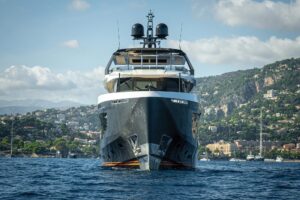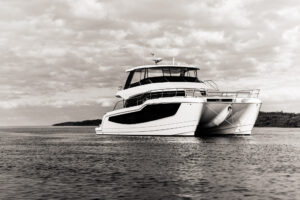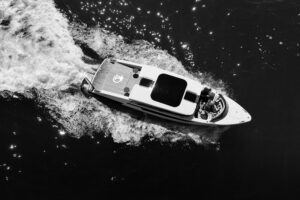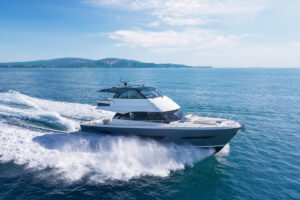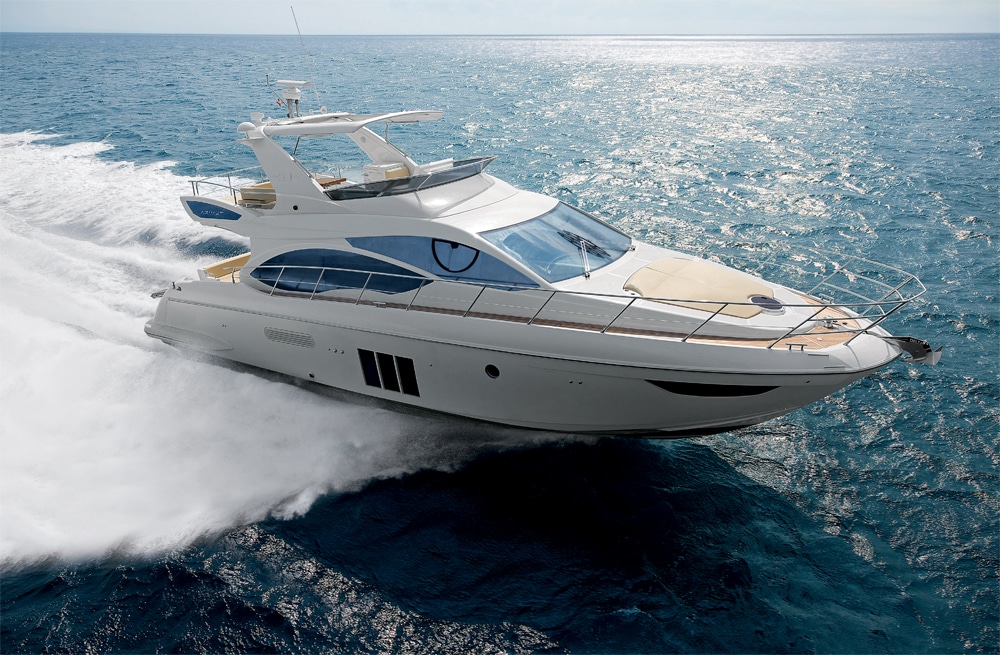
Azimut 53 Fly
The first mansion we passed on the way to the ocean had Doric columns supporting a sun deck that overlooked a never-ending pool. Our captain called that “the starter mansion.” Each house on the row was more and more grand as we idled along, taking in the view from the flying bridge of the new Azimut 53.
The stretch of manatee zones in the Intracoastal Waterway in Fort Lauderdale, Florida, as well as the scheduled bridge openings, dictated that we would have an hour’s cruise at idle speed. This is not the best time to judge a boat’s performance, but it’s a great way to figure out its sense of place. In this gantlet of posh and even bold houses, most with backyard docks, the Azimut 53 Fly more than belonged.
Any folks sitting poolside or on a veranda along our route would have taken in a vessel with elegant European lines and a tapered profile accentuated with bold, curved windows and a raked windshield on the main deck. On the topsides they would have seen the large rectangular panel of windows that is distinctly Azimut, and that sheds light on an integral area belowdecks.
The full-beam master stateroom amidships is one of the more spacious you’ll find aboard a 53-foot motoryacht. Those window panels brightened the room with Florida sunshine, enhanced by the light oak wood and coordinated fabrics. The brown leather accents and darker blinds accentuated the room’s pale palette. I’m 5 feet 11 inches and, to me, the stateroom felt even more spacious than its 6-foot-4-inch headroom, thanks to the lighting.
The bright and airy theme carries through the forward guest stateroom and another guest room with over/under bunks, all the way to the main deck, where a similar palette of light-colored oak, brown faux leather, and fabrics decorate the helm and salon. The curved windows and sliding glass door abaft give 360-degree views, so you will never lose sight of the fact that you are at sea. The lower helm station can be electronically adjusted for sitting or standing, and in either position the two screens for the Raymarine G Series electronics suite were easily viewed. Our sea-trial boat featured the Easy Docking System that Azimut designed with Xenta Systems. It’s a joystick control that allows you to work the thrusters in conjunction with the engines to get close-quarters maneuverability similar to that of boats with pod-drives.
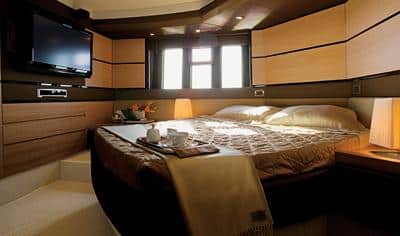
While we were on our jaunt through the Intracoastal, the Easy Docking System showed its real-world worth, since we could easily hold position and work nimbly around other boats waiting for the bridges to open. (I should add that later, at the dock, the captain used the system to back into the tightest slip with the craziest currents imaginable. For this, I thought it wise to merely observe.)
For all the natural light that bathes the interior, I’m one who prefers to run a boat in the open air, and if I owned the 53, I would work from the flying bridge helm station 99 percent of the time. Luckily, it’s well suited to bringing the party upstairs. The helm station sits to port behind a reverse-raked windshield, and from here it was, truthfully, much easier to monitor the small boats that dodged around us, blissfully unaware. What I loved most about the flying bridge, though, was the large sun lounge to starboard of the helm. The cushions run seamlessly aft along the starboard side into a dinette, and then aft to another sun lounge that takes advantage of the extended bridge. To escape the sun, the arch supports a hardtop with a retractable fabric roof. The entire aft area of the bridge is protected by a safety rail that runs almost waist high — a height that is practical as well as aesthetically pleasing.
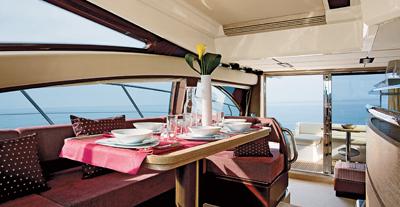
The long idle gave me plenty of time to check out every little detail, and I also liked what I saw in the teak-laden cockpit and extended swim platform. The hydraulically actuated gangway also has teak underfoot, and when retracted it sits vertically so it does not eat into usable space. Either side features pass-throughs in the gunwale, making for easy boarding no matter how you dock. A hatch in the sole revealed access to the Seakeeper gyro stabilizer installed on our test boat, designed to improve stability while at anchor and at full speed under way. However, I would have needed heavy seas to test this.
When we finally made it to the Hillsboro Inlet, we opened up the throttles to see what the twin MAN diesels could muster. We had excellent sea conditions, so we pushed the boat wide open to around 32 knots, and under way the 53 tracked beautifully. We arced sporty, graceful turns and tried to generate some spray over the bow by artificial means, but couldn’t do it. The 53 has a moderate V-hull that measures 12 degrees of deadrise at the transom, giving it a pleasurable ride for overnight or weekend cruises in moderate seas.
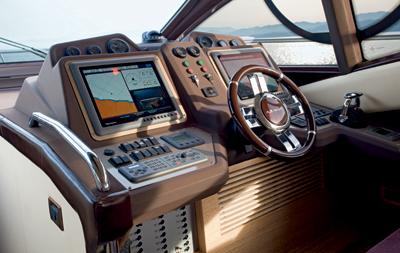
Running offshore, I noticed our electronics were still set to read in Italian. If we turned off the chart plotter, it would be impossible to distinguish whether we were cruising to Bimini or in the Mediterranean off the northwest coast of Italy, where Azimut designed and built the 53 before shipping her stateside. Wherever — she’ll fit right in.
LOA: 54’9″
LWL: 54’5″
Beam: 15’6″
Draft: 4’5″
Displ.: 48,501 lb.
Fuel: 618 gal.
Water: 156 gal.
Deadrise: 12 degrees
Engines Tested: 2 x 735-hp MAN V-8 1000 diesels
Standard Power: 2 x 715-hp Caterpillar C12 ACERT diesels
Price: Upon request
Azimut Yachts, MarineMax, 954-941-0524; www.azimutyachts.com

